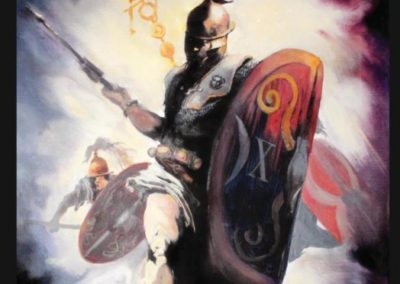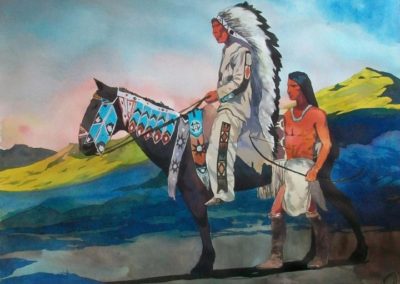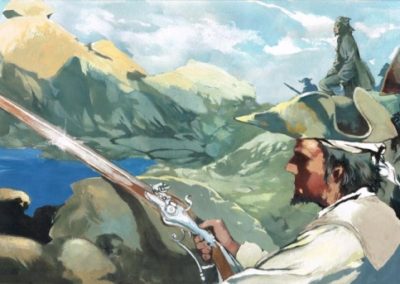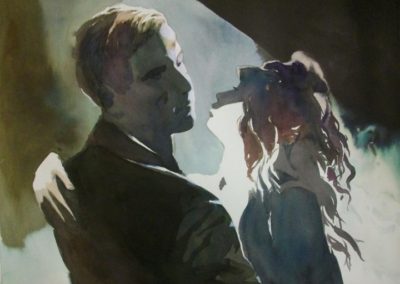Could you tell us a little about how you got here?
I studied at the Saint Luc Institute of Fine Arts in Liège, Belgium, where comic books quickly appeared to be my preferred medium for telling stories. I continued self-taught in order to test my the style to which I wanted to concrete my choice, which takes time. I say self-taught because the universe of drawing is vast, and all of the answers can’t be found in a university cycle.
To be a desinger, painter or illustrator, is to have fun. I therefore rapidly plunged into comic book projects, and the first one was released in 2002 under the title Planète Divine, a dreamlike science fiction story published by Glénat.
In visiting book shows, I met Tarek and we quickly got to know each other. What followed was a series of albums taking the shape of a trilogy, notably the second cycle of Sir Arthur Benton. Around 2010, we decided to invest in the independent publisher Tartamudo together, in order to develop the subjects we were most interested in, either together or separately. That allowed me to change my busy schedule, by exhibiting paintings and illustrations, in Switzerland and France, and to give courses in drawing at l’École Pivaut and courses in painting at the Ateliers Terre & Feu in Rennes, France.
You work a lot with watercolors. Why that choice?
The relationship with color immediately inspired me when I was in Saint-Luc. There was never a policy for or against digital tools. However, I was repeatedly advised not to follow this path, and that professionally it would discount my work. Drawing is above all an achievement and a reward in itself, then professional life should be organized around it. That is what resonates with people, and it is the best way to be appreciated, because honesty pays, discreetly but more surely.
My natural temperament goes well with painting in layers. For comic books, my path has brought me to work with watercolors in the form of ECOLINE inks. To work material through physical contact is a great pleasure.
What are your sources of inspiration?
For comic books, there are the American classics like Harold Foster or Alex Raymond, but also the best of dynamism, like Frazetta, Scott Hampton, Jeff Jones, or Berni Wrightson. A European author who has inspired me greatly and continues to do so, is the Vietnamese Vink, author of a beautiful poetic series “Le Moine Fou”, all in watercolors.
In painting and illustration, there are really many things. The art of the end of the 19th century and beginning of the 20th century especially speaks to me, whether it’s art nouveau, impressionism, Arthur Rackham and Edmond Dulac, ou even Carl Larsson.
What do you like most about historical comic books?
Geopolitics attract me because it’s a way of shedding light on the problems of society in a bipartisan way and trying to understand. Understanding allows us to find ways to overcome a problem. Culture allows us to share these observations and to understand the world better. For example, for The Gallic Wars, the game of alliances and hostages echoes what’s been happening up to modern days, and Caesar`s book is strongly oriented toward the psychology of adversaries and the morale of the troops.
For Sir Arthur Benton, it allows us to better understand the consequences which still afffect us, like the fact that the west served the Nazis in order to construct secret services against the USSR. Or again the way of reasoning of men in power, which is sometimes very paranoid. It’s an invitation to better popularize subjects which are difficult, and to contribute to an understanding of the consequences of our actions.
The fantastical is what I most naturally appreciate, because it allows us to make allegories and hyperbole that we accept more easily in this form, because it allows us to explore a certain universal depth, and also because imagining new worlds can set our minds free!
Can you tell us about your collaboration with Tarek, your scenarist?
Tarek is someone methodical and organized, who is also flexible enough to adapt to his illustrator. At least we get along well, he gives me the freedom to construct my pages, which is what I need.
What has made our professional relationship evolve is our respectful understanding and numerous shared passions. Otherwise I sometimes give a hand with Tarek’s magazine Paris Tonkar, where I was able to create an article on Vaughn Bodé and interview David Lloyd, the illustrator of V for Vendetta, a person of great elegance and an authentic gentleman.
Creation is an area where we have to be audacious, risk-taking, anticipate, and keep our feet on the ground. Tarek does that very well, which is enriching. Vivacity and flexibility must be balanced in order to be able to materialize things without being conditioned by the necessity of the materials or fleeting trends.














Do you love free graphic novels?
1. Sign up with your name and email address.
2. Fill out a short survey.
3. Check your inbox for your free graphic novel.
You have Successfully Subscribed!